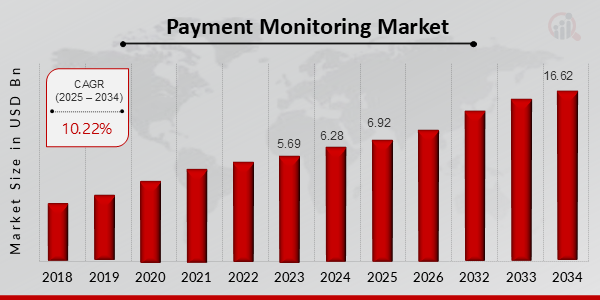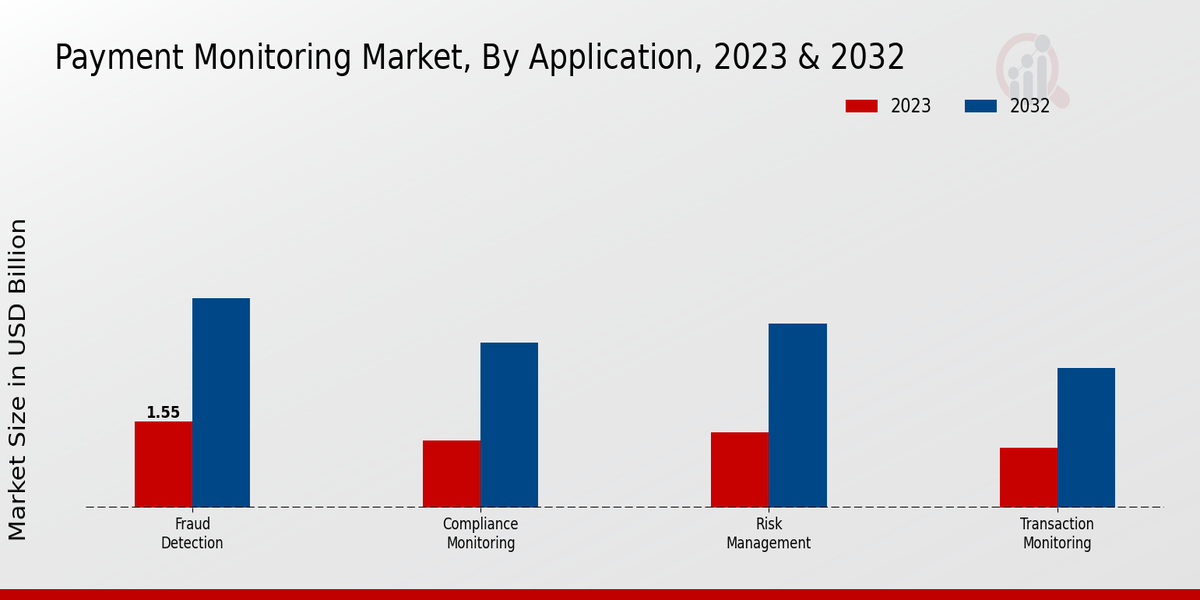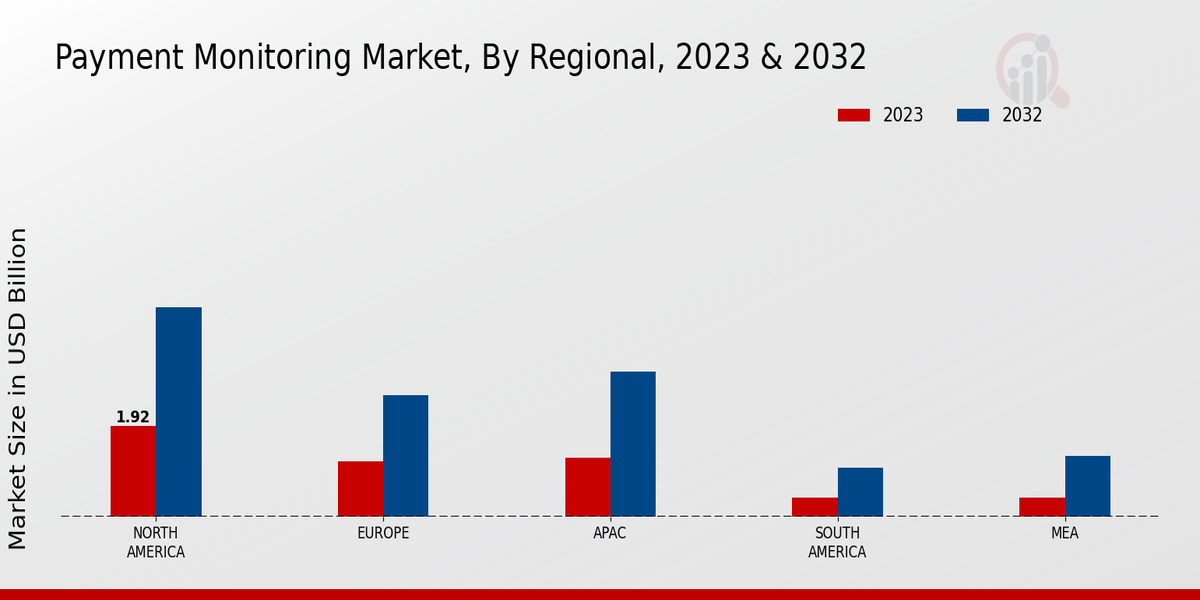Payment Monitoring Market Overview
Payment Monitoring Market is projected to grow from USD 6.92 Billion in 2025 to USD 16.62 Billion by 2034, exhibiting a compound annual growth rate (CAGR) of 10.22% during the forecast period (2025 - 2034). Additionally, the market size for Payment Monitoring Market was valued at USD 6.28 billion in 2024.
Key Payment Monitoring Market Trends Highlighted
The Payment Monitoring Market is influenced by several key drivers that are shaping its growth. Increasing regulatory requirements and compliance standards across various industries push organizations to invest in robust payment monitoring systems. With rising concerns over fraud and financial crimes, businesses recognize the need to adopt comprehensive monitoring solutions to safeguard their transactions. Additionally, advancements in technology, such as artificial intelligence and machine learning, enhance the ability to detect suspicious activities, driving demand for sophisticated payment monitoring tools. The growing trend toward digital payments also necessitates improved monitoring processes as more transactions migrate to online platforms.
Opportunities in the payment monitoring landscape are emerging as organizations seek to improve their security postures and streamline their operations. Companies can explore partnerships with technology providers to develop innovative monitoring solutions that integrate seamlessly with their existing systems. There is also potential in offering tailored services to different industries, enabling more effective risk management and compliance efforts. As new payment methods continue to emerge, businesses can capture market share by adapting their monitoring capabilities to accommodate these innovations while ensuring compliance with evolving regulations.
In recent times, there has been a notable increase in the adoption of payment monitoring solutions driven by the shift towards remote work and digital transactions. The COVID-19 pandemic accelerated the digital transformation, pushing companies to prioritize payment security and monitoring. There has also been a growing focus on enhancing user experience while maintaining security measures, leading to the development of more user-friendly interfaces in monitoring tools. This adaptability is crucial for organizations in a rapidly changing digital landscape as they seek to balance efficiency with effective risk management. Overall, the Payment Monitoring Market is poised for growth, characterized by ongoing technological advancements and heightened awareness of the importance of financial security.
Figure 1: Payment Monitoring Market Size, 2025-2034 (USD Billion)

Source: Primary Research, Secondary Research, MRFR Database and Analyst Review
Payment Monitoring Market Drivers
Increasing Regulatory Compliance Requirements
As the financial landscape evolves, regulatory compliance has become more stringent, driving the need for efficient payment monitoring solutions. Governments and regulatory bodies across the globe are implementing comprehensive regulations to combat money laundering, fraud, and other illicit activities. This regulatory push has resulted in a growing demand for Payment Monitoring Market Industry solutions that facilitate real-time transaction monitoring and reporting, ensuring organizations can adhere to these regulations.
Companies recognize that failing to comply with these rules can lead to significant financial penalties and reputational damage, making efficient payment monitoring tools indispensable. Additionally, the increasing focus on anti-money laundering (AML) and combating the financing of terrorism (CFT) has led businesses to prioritize investment in payment monitoring technologies. Organizations are continuously seeking comprehensive and automated solutions that can help them maintain compliance while also ensuring operational efficiency.
As the regulatory environment continues to evolve, the demand for advanced payment monitoring solutions will only intensify, highlighting its significance within the Payment Monitoring Market Industry.
Rising Fraudulent Activities and Cyber Threats
The recent years have witnessed a significant surge in fraudulent activities and cyber threats, prompting organizations to bolster their payment monitoring processes. Criminal enterprises are constantly evolving their tactics, making it imperative for businesses to adopt advanced monitoring solutions to combat these threats. The Payment Monitoring Market Industry is experiencing growth as firms seek to protect themselves from financial losses, negative publicity, and customer trust erosion caused by fraud.
Enhanced fraud detection mechanisms are essential for identifying suspicious transactions quickly and efficiently, enabling organizations to mitigate risks effectively.
Adoption of Advanced Technologies
The integration of advanced technologies such as artificial intelligence, machine learning, and big data analytics is revolutionizing the payment monitoring landscape. These technologies enable organizations to enhance the accuracy and efficiency of their monitoring processes, allowing them to analyze vast amounts of transaction data effectively. As the Payment Monitoring Market Industry continues to embrace these innovations, organizations are better equipped to recognize patterns, detect anomalies, and respond promptly to potential risks.
This adoption not only strengthens fraud prevention efforts but also supports overall business growth and operational efficiency.
Payment Monitoring Market Segment Insights
Payment Monitoring Market Application Insights
The Payment Monitoring Market is witnessing significant growth, particularly in the Application segment, which encompasses critical areas such as Fraud Detection, Compliance Monitoring, Risk Management, and Transaction Monitoring. In 2023, the market was valued at 5.17 USD Billion, reflecting a robust demand for advanced monitoring solutions. Fraud Detection emerged as a vital area, holding a market value of 1.55 USD Billion in 2023, and is expected to grow to 3.75 USD Billion by 2032, indicating its dominant position in safeguarding financial transactions against fraudulent activities.
This segment's growth can be attributed to the increasing sophistication of cyber threats and the heightened need for organizations to protect sensitive financial information. Compliance Monitoring also holds a significant share, with a valuation of 1.2 USD Billion in 2023, projected to rise to 2.95 USD Billion by 2032. The importance of this area lies in its role in ensuring adherence to regulatory demands, which are constantly evolving and becoming more stringent in combating financial crimes. Furthermore, Risk Management, with a valuation of 1.35 USD Billion in 2023 and expected growth to 3.3 USD Billion in 2032, plays a crucial role in identifying and mitigating risks associated with payment processing and transactions.
This segment is particularly significant for businesses seeking to manage their exposure to potential financial losses and reputational damage. Transaction Monitoring, while slightly lower in market share at 1.07 USD Billion in 2023, is essential for real-time tracking of transactions, projected to reach 2.5 USD Billion by 2032. This functionality enables organizations to detect and prevent suspicious activities immediately, underscoring the importance of maintaining secure and trustworthy transactional processes. The Payment Monitoring Market is thus characterized by its diverse applications, with each segment contributing uniquely to the industry's overall dynamics, ensuring compliance, reducing fraud, managing risks, and monitoring transactions effectively in an increasingly complex financial landscape.
The consistent growth across all applications showcases their essential role in advancing payment security and operational integrity, aligning with broader market trends and the growing technological innovations in the financial sector.

Source: Primary Research, Secondary Research, MRFR Database and Analyst Review
Payment Monitoring Market Deployment Model Insights
The Deployment Model segment of the Payment Monitoring Market reflects substantial growth and diversification, revealing preferences between On-Premise, Cloud-Based, and Hybrid solutions. As of 2023, the market stands at a valuation of 5.17 billion USD, driven by increasing demand for efficient payment processing and regulatory compliance. The Cloud-Based model has emerged as a favored option due to its scalability and accessibility, accommodating businesses of various sizes. Conversely, the On-Premise deployment continues to hold significant importance for organizations prioritizing data security and local control over their payment systems.
The Hybrid model combines benefits from both approaches, allowing organizations to tailor their payment strategies while maintaining flexibility in operations. The need for robust security measures, coupled with evolving customer expectations, fuels the growth in these deployment models. Furthermore, advancements in technologies and the rise of e-commerce activities are critical drivers for the Payment Monitoring Market revenue. Overall, these deployment models play a vital role in the market's evolution, responding to shifting industry dynamics and business requirements.
Payment Monitoring Market End User Insights
The Payment Monitoring Market is experiencing significant growth, with the market expected to be valued at 5.17 billion USD in 2023. This upward trend is driven by a variety of end users, significantly shaping the industry dynamics. The banking sector plays a crucial role, as it requires robust payment monitoring systems to mitigate fraud and ensure compliance with regulations. Similarly, the insurance sector demands effective monitoring solutions to prevent financial misuse. Retail and E-Commerce industries also contribute notably, where payment monitoring is essential for securing transactions and enhancing customer trust.
Government agencies are increasingly adopting payment monitoring technologies to streamline their financial operations and ensure transparency. Overall, the diverse applications across these sectors illustrate the vital importance of effective payment monitoring, addressing both efficiency and security needs in the ever-evolving market landscape. Given these trends, the Payment Monitoring Market data reflects a strong demand across various segments, impacting future development and investment strategies.
Payment Monitoring Market Technology Insights
The Payment Monitoring Market has seen significant growth in its Technology segment, with an overall market value reaching 5.17 USD Billion in 2023 and projections indicating further expansion. This sector is predominantly shaped by advanced technologies such as Artificial Intelligence, Machine Learning, Big Data Analytics, and Blockchain, which play crucial roles in enhancing payment security and operational efficiency. Artificial Intelligence and Machine Learning are fundamental in detecting fraudulent activities in real time, thereby providing effective solutions for risk management.
Big Data Analytics offers invaluable insights by processing vast amounts of transaction data, enabling better decision-making and predictive analytics. Furthermore, Blockchain technology is crucial for ensuring transparency and security within transactions, thus fostering trust among users. Together, these technologies form the backbone of the Payment Monitoring Market, driving innovation and presenting substantial opportunities for market expansion as they adapt to the evolving landscape of financial transactions and compliance. With projected market growth supported by these technological advancements, the sector promises to yield significant returns and reshape how payments are monitored globally.
Payment Monitoring Market Regional Insights
The Payment Monitoring Market is poised for substantial growth across various regions, reflecting a total value of 5.17 USD Billion in 2023. Among the key regions, North America holds the largest market share, with a valuation of 1.918 USD Billion in 2023, which is significant given its advanced infrastructure and early adoption of payment technologies, leading to a projected value of 4.429 USD Billion by 2032. Europe, valued at 1.167 USD Billion in 2023, follows as a strong contender due to strict regulatory frameworks driving demand for robust payment monitoring solutions, expected to reach 2.577 USD Billion by 2032.
The Asia-Pacific (APAC) region is emerging rapidly, with a market value of 1.251 USD Billion in 2023, reflecting its growing digital economy and increasing mobile payments, likely to grow to 3.06 USD Billion by 2032. In contrast, South America and Middle East Africa (MEA) are smaller but growing markets, each starting with 0.417 USD Billion in 2023 for South America and witnessing potential growth to 1.047 USD Billion and 1.288 USD Billion, respectively, by 2032. These regions signify a diverse landscape of opportunities and challenges, characterized by differing regulatory environments and technological advancements, which influence the Payment Monitoring Market data and overall market growth.

Source: Primary Research, Secondary Research, MRFR Database and Analyst Review
Payment Monitoring Market Key Players and Competitive Insights
The Payment Monitoring Market is characterized by a robust competitive landscape that has been shaped by the continuous evolution of financial technologies, regulatory frameworks, and consumer expectations. Key players are focused on enhancing their product portfolios and strengthening their market positions through innovation and strategic partnerships.
Competition is driven not only by the need for compliance with increasingly stringent financial regulations but also by the demand for effective risk management solutions that can adapt to the rapidly changing payment ecosystem. Companies are embracing advanced analytics, artificial intelligence, and machine learning to provide real-time monitoring capabilities that improve the detection of fraudulent transactions while ensuring a seamless customer experience. As the market continues to grow, businesses must also stay agile, responding to emerging challenges and opportunities to maintain a competitive edge.
SAS has established a notable presence in the Payment Monitoring Market, leveraging its strengths in advanced analytics and data management to deliver comprehensive solutions. The company is renowned for its sophisticated algorithms and machine learning capabilities that enhance the accuracy of risk assessments and fraud detection processes. SAS offers businesses real-time monitoring tools that support compliance with regulatory requirements while minimizing the risks associated with fraudulent activities. Its ability to integrate seamlessly with existing payment systems and provide actionable insights is a key differentiator that strengthens its market position. Furthermore, SAS's commitment to innovation ensures that its offerings remain aligned with the latest industry trends, bolstering customer trust and satisfaction.
FICO is also a prominent player in the Payment Monitoring Market, recognized for its expertise in predictive analytics and fraud management solutions. The company provides a robust suite of technologies that empower organizations to monitor financial transactions effectively and respond promptly to suspicious activities. FICO's distinctive strengths lie in its ability to harness big data analytics, enabling clients to gain deeper insights into their transaction patterns and emerging threats.
By focusing on enhancing both the accuracy of fraud detection and the efficiency of the payment process, FICO helps organizations mitigate risks while maintaining high levels of service quality. Its strong reputation and market experience make it a trusted partner for many businesses looking to optimize their payment monitoring frameworks in an increasingly complex financial landscape.
Key Companies in the Payment Monitoring Market Include:
Payment Monitoring Market Industry Developments
The Payment Monitoring Market has seen significant developments, particularly with increasing regulatory scrutiny and the demand for enhanced fraud prevention measures. Companies such as SAS, FICO, and NICE Actimize are advancing their technologies, focusing on AI and machine learning to enhance transaction monitoring capabilities. Furthermore, recent trends indicate a substantial growth in the market valuation as organizations like Experian and PayPal expand their offerings to meet evolving customer expectations.
In terms of mergers and acquisitions, significant activities include SAS acquiring a niche analytics firm to bolster its fraud detection prowess and FICO's strategic partnership with LexisNexis Risk Solutions to enhance its data analytics capabilities for more accurate risk assessments. These movements are indicative of a rapidly evolving landscape wherein companies are looking to strengthen their positions through innovation and strategic alliances. The overall growth in market valuation is driven by the increasing need for compliance and risk management solutions, highlighting the importance of effective payment monitoring systems across various sectors. As businesses continue to digitize their payment processes, the reliance on robust monitoring solutions is more critical than ever.
Payment Monitoring Market Segmentation Insights
-
Payment Monitoring Market Application Outlook
-
Fraud Detection
-
Compliance Monitoring
-
Risk Management
-
Transaction Monitoring
-
Payment Monitoring Market Deployment Model Outlook
-
On-Premise
-
Cloud-Based
-
Hybrid
-
Payment Monitoring Market End User Outlook
-
Banking
-
Insurance
-
Retail
-
E-Commerce
-
Government
-
Payment Monitoring Market Technology Outlook
-
Artificial Intelligence
-
Machine Learning
-
Big Data Analytics
-
Blockchain
-
Payment Monitoring Market Regional Outlook
-
North America
-
Europe
-
South America
-
Asia Pacific
-
Middle East and Africa
| Report Attribute/Metric |
Details |
|
Market Size 2024
|
6.28 (USD Billion)
|
|
Market Size 2025
|
6.92 (USD Billion)
|
|
Market Size 2034
|
16.62 (USD Billion)
|
|
Compound Annual Growth Rate (CAGR)
|
10.22% (2025 - 2034)
|
|
Report Coverage
|
Revenue Forecast, Competitive Landscape, Growth Factors, and Trends
|
|
Base Year
|
2024
|
|
Market Forecast Period
|
2025 - 2034
|
|
Historical Data
|
2019 - 2023
|
|
Market Forecast Units
|
USD Billion
|
| Key Companies Profiled |
SAS, FICO, Oracle, Experian, Fraugster, PayPal, NICE Actimize, Thomson Reuters, ACI Worldwide, LexisNexis Risk Solutions, ComplyAdvantage, FIS, Informa, ID Analytics, Verafin |
| Segments Covered |
Application, Deployment Model, End User, Technology, Regional |
| Key Market Opportunities |
Integration with AI technologies, Growth in e-commerce transactions, Enhanced regulatory compliance requirements, Demand for real-time transaction monitoring, Rising importance of cybersecurity measures |
| Key Market Dynamics |
Regulatory compliance requirements, Rise in fraud incidents, Increased digital payment adoption, Advancements in technology, Growing demand for real-time monitoring |
| Countries Covered |
North America, Europe, APAC, South America, MEA |
Frequently Asked Questions (FAQ) :
The Payment Monitoring Market is expected to be valued at 16.62 USD Billion in 2034.
The projected CAGR for the Payment Monitoring Market from 2025 to 2034 is 10.22%.
The Fraud Detection segment held the largest market value at 1.55 USD Billion in 2023.
The market size for Compliance Monitoring is expected to reach 2.95 USD Billion in 2032.
North America is expected to dominate the Payment Monitoring Market with a value of 4.429 USD Billion in 2032.
The expected market value for Transaction Monitoring in 2023 is 1.07 USD Billion.
The Risk Management segment is projected to be worth 3.3 USD Billion in 2032.
The anticipated market size for the APAC region in 2032 is 3.06 USD Billion.
Prominent players include SAS, FICO, Oracle, Experian, and PayPal, among others.
The expected market size for South America in 2032 is projected at 1.047 USD Billion.

















